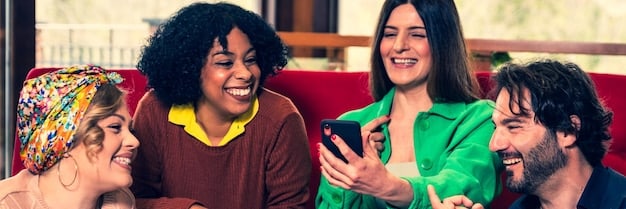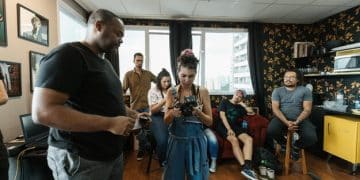The Power of Representation: Diversity & Inclusion in Series

The power of representation is transforming television, fostering broader understanding and empathy by portraying diverse experiences and identities within series, moving beyond tokenism to embrace authentic inclusion.
In an increasingly interconnected world, the stories we see on screen profoundly shape our perceptions and understanding. Among the most impactful narratives are those exploring The Power of Representation: Examining Diversity and Inclusion in Series. This exploration delves into how television series are evolving to reflect the world’s rich tapestry of human experience, moving beyond superficial portrayals to foster genuine empathy and understanding.
Beyond the Screen: The Intrinsic Value of Representation
Representation within media, particularly in series, is far more than just a fleeting trend. It is a fundamental pillar for fostering a more inclusive and empathetic society. When individuals see themselves, their cultures, and their experiences authentically reflected, it validates their existence and combats feelings of isolation. This recognition is crucial for identity development, especially for younger audiences who are naturally forming their understanding of the world and their place within it.
The absence of diverse characters or the perpetuation of stereotypes can have detrimental effects. It can lead to internalised biases, feelings of invisibility, or even shame regarding one’s identity. Conversely, positive and nuanced representation empowers individuals, builds self-esteem, and cultivates a sense of belonging. The intrinsic value lies in its ability to mirror the diverse reality of our global community, ensuring that everyone feels seen, heard, and valued.
Breaking Down Stereotypes and Fostering Empathy
One of the most significant contributions of strong representation is its capacity to dismantle harmful stereotypes. When characters from underrepresented groups are depicted with depth, complexity, and individuality, they challenge preconceived notions and broaden viewers’ perspectives. This nuanced portrayal allows audiences to connect with characters on a human level, transcending superficial differences.
- Stereotypes often reduce individuals to a single, oversimplified trait, hindering genuine understanding.
- Nuanced characters reveal the multifaceted nature of human experience, promoting a more holistic view.
- Exposure to diverse narratives builds empathy, enabling viewers to understand varied perspectives.
- This understanding can translate into real-world changes in attitudes and behaviors.
Moreover, empathetic engagement is a two-way street. Not only do viewers from dominant groups learn to appreciate differences, but individuals from underrepresented groups see possibilities for themselves previously unimagined. This fosters aspiration and confirms that their stories are worthy of being told, strengthening their sense of identity and challenging societal limitations.
Historical Context: Evolution of Diversity in Television
The journey towards diverse representation in television has been long and arduous, marked by incremental progress and significant setbacks. Early television, particularly in the mid-20th century, largely reflected the dominant cultural narratives of the time. Characters were predominantly white, male, and heteronormative, with minorities often relegated to stereotypical or caricature roles, if present at all. This narrow portrayal solidified existing biases rather than challenging them.
The late 20th century saw the emergence of groundbreaking shows that began to push the boundaries, albeit slowly. Series like “The Cosby Show” in the 1980s, despite later controversies, were praised for depicting an affluent African-American family, offering a counter-narrative to prevalent stereotypes. Similarly, LGBTQ+ characters started to appear, often in minor roles or with ambiguous storylines due to societal taboos and network cautiousness.
Milestone Series and Changing Tides
The turn of the millennium brought a more pronounced shift. The rise of cable television and later streaming platforms provided more avenues for niche storytelling and reduced dependence on broad appeal, allowing for bolder choices in character development. Shows like “Will & Grace” (1998) brought gay characters into mainstream living rooms with humor and relatability, pioneering increased visibility.
- “The L Word” (2004) offered an ensemble cast primarily focused on lesbian characters, a rarity at the time.
- “Grey’s Anatomy” (2005) consistently featured a diverse cast across various ethnicities and sexual orientations.
- “Orange Is the New Black” (2013) showcased a wide array of female characters from different racial, economic, and sexual backgrounds.
These series, among others, demonstrated that diverse stories could be both critically acclaimed and commercially successful, paving the way for the current era of heightened awareness and demand for authentic representation. The growth of streaming services has further accelerated this trend, offering platforms willing to invest in stories from underrepresented creators and perspectives.
Key Dimensions of Diversity and Inclusion in Series
Diversity is a multifaceted concept, encompassing far more than just race or gender. When we discuss inclusion in series, it’s essential to consider the broad spectrum of human identity. This holistic approach ensures that representation is not just tokenistic but genuinely reflective of the world’s population.
Dimensions of diversity include, but are not limited to, race, ethnicity, gender, sexual orientation, disability, socioeconomic status, religion, age, and body type. True inclusion means not only depicting characters from these diverse backgrounds but also embedding their experiences and perspectives into the very fabric of the narrative, ensuring they are central to the story, not just tangential additions.
Race and Ethnicity: Beyond Stereotypes
For decades, representation of racial and ethnic minorities was often limited to harmful stereotypes or token characters. Today, there’s a growing push for authentic, nuanced portrayals that reflect the rich tapestry of global cultures. This means not only casting diverse actors but also hiring diverse writers, directors, and producers who can bring lived experiences to the screen.
- African-American stories are evolving from historical dramas to contemporary narratives exploring various facets of identity and class.
- Asian-American representation is moving beyond immigrant stories to include complex narratives about identity, family, and professional life.
- Latinx characters are increasingly depicted in diverse roles, challenging monolithic cultural assumptions and showcasing a wide range of national origins and experiences.
The goal is to move beyond superficial representation to deep, authentic storytelling that explores the complexities of racial and ethnic identity within various social contexts. This also includes acknowledging and exploring intersectionality, where different aspects of identity combine to create unique experiences of marginalization or privilege.
LGBTQ+ and Disability Representation: Visibility and Authenticity
The LGBTQ+ community has seen significant strides in visibility, transitioning from coded characters to openly gay, lesbian, bisexual, transgender, and queer individuals portrayed with depth and normalcy. Series are increasingly exploring LGBTQ+ relationships, families, and challenges with sensitivity and authenticity, normalising these experiences for a broader audience.

Similarly, disability representation is gaining traction. Historically, characters with disabilities were either absent, portrayed as objects of pity, or used as plot devices. Modern series are beginning to cast actors with disabilities to play characters with disabilities, offering authentic perspectives and showcasing their full humanity, rather than defining them solely by their condition.
- The importance of “nothing about us without us” principle in casting and writing for authentic disability representation.
- Exploring the spectrum of LGBTQ+ experiences beyond coming-out stories, including relationships, parenting, and professional lives.
- Highlighting the challenges and triumphs of living with disabilities, without resorting to inspirational porn or tragic tropes.
These dimensions of diversity are crucial because they directly impact the self-perception of millions and shape societal attitudes towards these groups. Authentic portrayal can reduce prejudice and promote greater understanding and acceptance in real-world interactions.
The Business Case for Diversity: Audiences and Revenue
While the ethical and social arguments for diversity are compelling, there is also a robust business case that drives its adoption in the entertainment industry. Diverse content resonates with diverse audiences, leading to increased viewership, subscriber growth, and ultimately, higher revenue. As global markets expand and demographics shift, companies that prioritize inclusion are better positioned for long-term success.
Studies consistently demonstrate that audiences are hungry for content that reflects their own experiences and the diversity of the world around them. This demand is not limited to minority groups; mainstream audiences also appreciate nuanced and authentic storytelling that broadens their perspectives. Series that accurately depict diverse cultures and identities often receive critical acclaim, generate positive buzz, and foster strong, loyal fan bases. This engagement translates directly into profitability through subscriptions, merchandise sales, and advertising revenue.
Attracting and Retaining Diverse Audiences
With the proliferation of streaming platforms and the sheer volume of content available, attracting and retaining viewers is more challenging than ever. Diversity acts as a powerful differentiator. When a series features authentic representation, it stands out in a crowded market and appeals directly to demographics that have historically been underserved or misrepresented.
- Diverse casting alone is not enough; rich narratives that embed diverse experiences are key.
- Content that genuinely reflects various cultures and backgrounds fosters deeper engagement and loyalty.
- Word-of-mouth recommendations among diverse communities significantly boost viewership.
- Inclusive content can tap into global markets more effectively, expanding audience reach.
Furthermore, diversity behind the camera — in writing rooms, director’s chairs, and executive suites — is critical for ensuring authenticity and avoiding missteps. Diverse creative teams bring diverse perspectives, leading to richer, more compelling stories that resonate broadly. This holistic approach to diversity, both in front of and behind the camera, builds trust with audiences and bolsters a positive brand image, proving that good ethics can lead to good business.
Challenges and the Path Forward for Inclusive Storytelling
Despite significant progress, the journey towards truly inclusive storytelling is far from over. Several challenges persist, from overcoming ingrained industry biases to ensuring that representation is authentic and not merely performative. Tokenism, for instance, where a single diverse character is included to check a box, fails to address the deeper need for genuine inclusion and varied perspectives. Such superficial gestures can often do more harm than good, reinforcing the idea that diversity is an obligation rather than an opportunity for richer storytelling.
Another hurdle is the risk of alienating audiences unaccustomed to diverse narratives or those resistant to change. However, as viewership data increasingly shows, the market for inclusive content is growing rapidly, making this less of a significant barrier than it once was. Overcoming these challenges requires continuous effort, conscious decision-making, and a commitment from all levels of the entertainment industry.
Authenticity, Nuance, and Avoiding Tokenism
The pursuit of authenticity is paramount. It involves moving beyond surface-level representation to explore the full humanity of diverse characters. This means:
- Involving people from the communities being represented in the creative process, from writing to consulting.
- Developing characters with complex inner lives and motivations, not just defined by their identity markers.
- Avoiding tropes and clichés that perpetuate stereotypes, no matter how subtly.
- Portraying diverse characters in a variety of roles and settings, demonstrating their full integration into society.
The path forward demands a sustained commitment to these principles. It’s not enough to cast diverse actors; the stories themselves must be inclusive, offering fresh perspectives and challenging conventional narratives. The industry needs to invest in nurturing diverse talent, ensuring that pipelines for writers, directors, and executives are robust and equitable.
The Role of Viewers and Critics in Driving Change
While creators and industry executives hold significant power in shaping media, the role of viewers and critics cannot be overstated. Audience demand is a powerful catalyst for change. Through their viewing choices, their social media engagement, and their direct feedback, viewers signal to the industry what kind of content they want to see. High viewership numbers for diverse shows send a clear message that inclusive stories are both desired and profitable.

Critics also play a vital role in elevating the discourse. By reviewing shows through the lens of representation and inclusion, they can highlight both successes and shortcomings. They can provide valuable insights into why certain portrayals resonate and others fall flat, guiding creators towards more authentic and impactful storytelling. Their analysis not only informs the public but also influences industry decisions and awards, further incentivizing diverse content creation.
Advocacy and Grassroots Movements
Beyond individual viewing habits, organized advocacy groups and grassroots movements have been instrumental in pushing for greater diversity. These organizations conduct research, publish reports, and directly lobby studios and networks for change. Social media campaigns often amplify their messages, bringing widespread attention to issues of underrepresentation and misrepresentation.
- Organizations like GLAAD, USC Annenberg Inclusion Initiative, and The Geena Davis Institute on Gender in Media provide data and insights.
- Fan activism on platforms like Twitter and TikTok can bring underrepresented voices to the forefront.
- Petitions and boycotts, though sometimes controversial, have historically prompted industry shifts.
Ultimately, the synergy between creators, industry decision-makers, viewers, and critics is what will continue to drive progress. It’s a collaborative ecosystem where each component plays a crucial part in ensuring that series truly reflect the world we live in, enhancing both their cultural relevance and commercial success.
Future Trends: What’s Next for Representation in Series?
The landscape of representation in series is continuously evolving, driven by societal shifts, technological advancements, and a growing understanding of what authentic inclusion truly entails. Looking ahead, several key trends are likely to shape how diversity is portrayed on screen. One significant development is the increasing focus on intersectionality, recognizing that individuals hold multiple identities that intersect to create unique experiences of identity and belonging. For instance, a character might be a Black, queer, disabled woman; exploring all these facets authentically presents a more holistic and accurate human experience, moving beyond single-axis representation.
Another emerging trend is the deeper exploration of neurodiversity and mental health. As awareness grows, series are moving beyond stereotypical portrayals to offer nuanced insights into conditions like autism, ADHD, anxiety, and depression. This includes depicting characters who are neurodivergent as fully formed individuals, not just defined by their diagnosis, and showcasing the complexities of living with mental health challenges in a way that destigmatizes and educates.
Global Perspectives and Transnational Storytelling
The rise of global streaming platforms is also accelerating the demand for and availability of transnational storytelling. This means not only series from different countries gaining international audiences but also productions that actively feature diverse global casts and settings, breaking down geographical and cultural barriers. Collaborations between international production companies are likely to increase, leading to stories that naturally blend multiple cultural perspectives and languages.
- Increased funding for international co-productions featuring diverse global talent.
- Exploration of cultural nuances within diasporic communities worldwide.
- Greater integration of multiple languages and subcultures within single narrative frameworks.
- A move away from Western-centric narratives, spotlighting stories from previously underexplored regions.
Finally, virtual production technologies, AI-driven content creation tools, and immersive experiences like VR are set to transform how stories are told and consumed. These technologies could democratize content creation further, allowing a broader range of voices to produce and share their stories, potentially leading to an explosion of diverse narratives from independent creators. The future of representation in series promises to be more complex, authentic, and globally interconnected than ever before, fostering empathy and understanding on an unprecedented scale.
| Key Aspect | Brief Description |
|---|---|
| 💖 Inclusivity | Representation validates identity and fosters belonging. |
| 🧠 Empathy | Nuanced characters break stereotypes, building understanding. |
| 💰 Business Case | Diverse content attracts wider audiences and boosts revenue. |
| 🔮 Future Trends | Intersectionality, neurodiversity, and global stories are next. |
Frequently Asked Questions About Representation in Series
▼
Authentic representation is crucial for validation and empathy. It allows individuals from underrepresented groups to see themselves truthfully portrayed, fostering self-esteem and a sense of belonging. For broader audiences, it breaks down stereotypes, promoting understanding and reducing prejudice by showcasing diverse human experiences beyond superficial traits.
▼
Initially, early TV was largely homogenous, dominated by white, male, heterosexual characters, with minorities often stereotyped. Over time, landmark series began challenging norms, followed by streaming platforms accelerating this shift. Today, there’s a greater emphasis on nuanced portrayals across race, gender, sexuality, and disability, reflecting a more global and diverse audience base.
▼
Diversity in series encompasses a wide range of identities beyond race and gender. It includes ethnicity, sexual orientation, disability, socioeconomic status, religion, age, and body type. True inclusion means these dimensions are not just visibly present, but their associated experiences and perspectives are deeply embedded into the narrative, moving beyond tokenism.
▼
Absolutely. There is a strong business case for diversity. Diverse content attracts and retains wider audiences, leading to increased viewership, subscriber growth, and higher revenue. Studies consistently show that series that authentically reflect varied experiences resonate more deeply with global audiences, resulting in critical acclaim, positive buzz, and stronger financial performance.
▼
Viewers play a crucial role by exercising their consumption power. High viewership of diverse shows signals demand to the industry. Their engagement on social media, direct feedback, and participation in advocacy groups also push for change. Audience support translates into commercial success and encourages studios to greenlight more inclusive and authentic projects.
Conclusion
The journey of representation in series is a testament to the evolving dynamics between media, society, and identity. What began as a nascent effort to include a wider array of faces has transformed into a profound movement championing authentic storytelling that reflects the world’s rich, multidimensional tapestry. From pioneering early shows to the nuanced narratives of today’s streaming era, the power of seeing oneself, and others, honestly portrayed transcends entertainment—it fosters empathy, breaks down barriers, and validates lived experiences. As audiences continue to demand content that mirrors their realities and industry stakeholders increasingly recognize the social and commercial imperatives of diversity, the future of series promises to be more inclusive, impactful, and truly representative of humanity’s vast and varied stories. This ongoing evolution is not just about fairness; it is about enriching our collective understanding and building a more connected world, one screen at a time.





